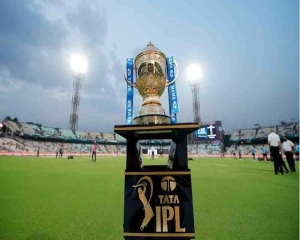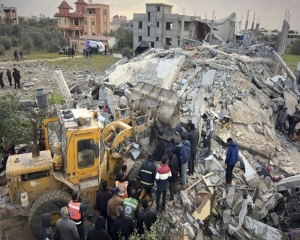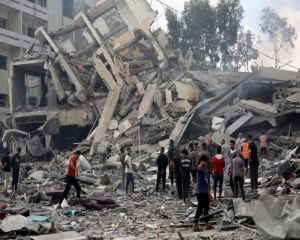On World Water Day, let us recount our engagement with rivers — the unsurpassed carvers of Earth, lifeline of human history and its future. let rivers run the course, and not just on the maps
Rivers as sacred thread of yajna
Rivers are ancient and older than the flow of human blood — a ‘mini cosmos’ spawning history, tales, spirituality and technological incursions. Flowing rivers are the largest renewable water resource for humans and a crucible of aquatic ecosystem. Rivers also have a habit of moving on and on from the source where they gush with gay abandon to their mouth where they quietly disappears into the surroundings. That journey is now being interrupted. Since the age of industrialisation, humans have increasingly exerted a pervasive influence on water resources. Rivers in particular have drawn humans to monumental engineering interventions such as dams and barrages often as chest-thumping dominance and seldom as an enduring bond between man and nature.
As a result we are swimming against the tide of unlearnt history and bad modern water policies. Most of the world rivers today are in a state of crisis, of degeneration and degradation. This is serious and frightening. Eighty per cent of the world population resides on the banks of rivers and their well-being will be threatened by increasing water pollution and flow fluctuation. While each river has its own distinct identity and profile, when it comes to vulnerability and stresses it is astonishingly common such as intensive water use for agriculture, unregulated industrial development and waste flow, and river habitat modification.
As rivers and water bodies become central to economic development and urbanisation, it will be important for national policies to look at the world as a network of rivers and as ecological systems interacting with their drainage basins and the atmosphere. Often policies lack sensitivity towards basic values like equity, transparency, accountability, sustainability and participation of the people in water policy processes. The beauty of successful river cleaning and rejuvenation is that it is not all about investing billions but equally developing inter-disciplinary and inter-ministerial strategies. Rivers thus have to be reconceptualised as a relationship of history, culture and ecology, and to be treated as endowments to be sustained for future generations.
River Development & Ganga Rejuvenation
Possibly one of the most modernising policy approaches of the Narendra Modi Government has been to raise the profile of rivers. For the current Government, water is indispensable to governance and development plans, livelihood and healthy life, expressed as sujalam sufalam (water for prosperity) and Swachh Bharat Abhiyaan. The earlier Ministry of Water Resources has now expanded to include River Development and Ganga Rejuvenation. likewise, Drinking Water and Sanitation, which was a department under the Ministry of Rural Development is now a full-fledged ministry with a Cabinet rank minister. These are early indicators, hopefully, to a more serious rethinking, readjustment and enhancement on water approaches and technologies as various water projects are witnessing widespread negative ecological and livelihood impacts.
A stable supply of quality water is an essential requirement for guaranteeing socio-economic-political stability. Ganga becomes central to river conceptualisation, cleaning and planning in India. With a length of 2,525-km, Ganga is the longest river of India and the second largest river in the world in amounts of water discharge. But with a fecal coliform count, at some stretches, drastically overshooting the quality limits, the water is lethal for drinking, bathing and even irrigation. Ganga is the fifth most polluted river in the world. While this remains a shameful reality, it is important to continuously reinstate the symbolism of Ganga — as the river of faith, devotion and worship. Rabindranath Tagore expressed it beautifully as the sacred thread of Indian yajna — connecting years of wisdom, religion and meditation. There is Ganga in every part of India and the emblematic interpretations can be a collective force of change.
The Ganga and many other rivers will represent numerous difficulties of development and management. For one, cleaning the rivers cannot be separated from rejuvenating the flow. But rivers also need to be harnessed for the wider national need. Economic development and requirement of energy and food cannot be divorced from developing rivers in terms of storage for irrigation and electricity generation. This is critical as India’s current urban population (410 million) will double by 2050. The ‘smart cities’ plan in 100 cities across India cannot be sustainable without more intelligent human-nature symbiosis. The challenge is to balance environmental, human, cultural, pilgrimage and economic interests within the complex system of a major river.
A river has to be planned as a whole and not as parts. Basin planning with attention on marginalised rivers (tributaries, rivulets and torrents) and not just the mainstream ones are crucial. The upstream, middle course and the delta will require greater efforts of integrating and harmonising with careful study, data analysis, federal cooperation and consultation.
One of the neglected aspects of river development in India has been navigation. The golden age of navigation in the Ganga was mid-19th century with steamers of the East India Company plying as far upstream as Garhmukteshwar. But with the development of the upper Ganga canals and the railways, navigation was effectively grounded. This needs to be revived. Using connected rivers for logistics and freight movement is a cleaner form of transport. Importantly, a thrust towards navigation will also drive planning towards maintaining flow and a relook at the development on the upper catchments area.
Rivers aren’t polluted, our actions are
Half of the world’s major rivers are badly polluted or depleted. Pollution caused by runoff from agricultural chemicals, poorly managed industrial processes, and lack of adequate treatment for sewage and other urban waste is the most serious threat to rivers and remains a challenging issue. Food is grown in ways that send pollution into the water, products are manufactured using more water than needed and forests are cleared without considering the dangers of erosion. It is rightly said that humans and ecosystem suffer when rivers are badly managed. Globally some great works have been achieved in improving the state of the rivers. Some remain sadly uncared for and some have sunk due to bad approaches and forced solutions.
Rivers in the past decades were like poetry, supposed to be instructive but in an unnoticeable manner. Now increasingly many rivers are less rhythmic and cry for help in very noticeable ways. India’s river clean-up mission can greatly benefit from the lessons on international river basins. Below is a snapshot of the facts on some of the international rivers. This can be a useful source of information on good practices and the bad experiences for our own river management.
International rivers and lessons
Singapore River: Unprecedented urbanisation in Singapore in the 1960s led to a new urban development plan keeping in mind the health of the Singapore river. From 1977 to 1983, the river’s condition had improved dramatically through dredging, rebuilding the river walls and the construction of a 6-km-long promenade along both banks of the waterfront. Today, Singapore river is an attractive waterfront environment for housing, recreation and entertainment.
lesson: City development synchronising with river and water bodies.
Alleghany and Monongahela rivers in Pittsburgh: Pittsburgh in the early 20th century had the highest rate of typhoid fever in the US as the rivers were dumping areas for untreated waste. This practice continued even till the 1950s, turning the rivers lifeless with no aquatic existence. But with a series of wastewater treatment plants and awakening campaigns and with local and national laws by the 1970s, the rivers are populated by fish and also support a large waterfowl.
lesson: Public awakening and initiative; implementation of laws.
Citarum River in Indonesia: Citarum, the biggest river basin in Java is probably the world’s most garbage-choked river. The textile factories operating at Citarum’s upper course were the main culprits in the 80s. The ADB has approved US $500 million to help the Government’s efforts to clean and rehabilitate the river by constructing solid waste facilities and wastewater treatment plants. There is also a serious problem of corruption and implementation. The expected timeline is 25 years before the Citarum can return to its pristine state.
lesson: Upstream waste management and misuse of funds.
Cuyahoga River in Ohio: In 1969, the Cuyahoga River in Ohio, described as an oily river that oozed than flowed, became famous for being “the river that caught fire”. The incident resulted in a massive environmental campaign in the US in the 1970s. Earlier the mindset of the Cleveland people was that prosperity came at an environmental cost which was a necessary consequence.
The attitude started changing in the early 60s, and in 1968 Cleveland residents overwhelmingly passed a $100 million bond initiative to fund the Cuyahoga’s cleanup.
lesson: Public awakening and initiative.
lake Karachay, Russia: lake Karachay, at a point of time, was the most polluted site. In the early 50s, the Soviet Union used the lake as a dumping spot for nuclear waste. Reports suggest that in 1968, radioactive dust from the lake irradiated half a million people.
The remediation method of covering the lake with stones and concrete was equally disastrous as the weight pushed the polluted sediments down and closer to the groundwater. Sometimes searching for a solution can lead to other difficult problems.
lesson: In-depth study and evaluation before undertaking actions.
Matanza-Riachuelo River, Buenos Aires: Scientific studies have revealed that the water of this river is almost poison. Ironically 3.5 million people live in its contaminated basin. This river also reflects a classic case of misappropriation of funds. In 1993, $250,000,000 was set aside for a clean-up project but only $1,000,000 was used to improve the condition of the water.
lesson: Corruption and misappropriation of funds.
Rhine, Central Europe: The Rhine in the 1970s was referred to as Europe’s sewer and the river delta in The Netherlands was described as the ‘cesspit’. Approximately 60 million people were affected by the pollution. A small group of concerned people in The Netherlands set up Reinwater Foundation to get the river cleaned up and started with legal proceedings against the French potassium mines on grounds of cross border pollution. The Rhine commission had set a target to bring back the salmon to the river by 2000. By 1997, the fish had returned.
lesson: litigation, compensation and regional approach. Raise a slogan and achieve the target.
The Danube/Black Sea, Central Europe: Danube is the most international river basin in the world that drains into the Black Sea. Pollution issues constantly dogged this river. One of the biggest source of river pollution was the over-production and poor handling of solid manure and liquid waste from raising livestock. Many farmers were not even aware of the problem and therefore their participation was critically important in the Danube River Basin Management Plan so that the Danube waters meet good ecological status by the end of 2015.
lesson: Participation of the people in water management processes; awareness campaign, and scientific research and analysis.
Mekong: The Mekong, the lifeline of South-East Asian states, is home to the world’s largest freshwater fisheries. Through fishing, aquaculture and irrigation, it sustains 65m people. The issue on the river is about upstream dams being built by China and laos and the flow impact on the fisheries and silt downstream. The Mekong demonstrates the significance of upstream actions and the need for coordination and transparency in the river management — this is not only between states abut also within states.
lesson: Downstream concerns will be significant, and upstream responsibilities in terms of pollution whether between states or within states will be crucial.
Yellow River, lanzhou, China: The water of the Yellow river in the lanzhou Province of China has over the years turned red due to contamination. The biggest threat to China will be poor quality of drinking water and water-borne diseases. It is reported that the Chinese Government has invested approximately $8,000,000,000 towards over 2,700 projects in eight rivers and lakes throughout the country.
lesson: No country can be a super power without its water resource in a pitiable state. Delayed action can lead to hard hitting costs.
Message in the management
By bringing in international river management know-how and experiences as well as adapting some of the state-of-the-art solutions, rivers can be restored. Three broad messages come out from the lessons mentioned above. First concerns the time-line. Most of the river cleaning programmes have a long history and a long-term plan. Such is the complexity and dynamic of the rivers. Thames, Rhine and Danube in Europe have taken a period of over 20 years to achieve the desired result.
A well-observed and realistic timeframe is required but also to have regular targets within the timeframe. Second relates to funds. Since, river cleaning is a dynamic process, there needs to be a continuous flow of funds for capital as well as operational costs. Sewage treatment plants (STPs) are going to be the mainstay of river cleaning. Allocation of funds and also seeking international assistance will be essential. Funding for such projects can be an important aspect of bilateral relations, given the technological and financial strength of the donor countries.
The third is the method. Development of rivers has to be democratic, participatory and multilateral. litigation also plays an important part in terms of public awareness. It becomes a critical aspect of good governance. Water policies have to remember that the flow of water in rivers is not merely material, it is also a flow of life and thus ensuring ecological preservation and sustainability is fundamental to the healthy functioning of the country.
Rivers are not a lost cause. Nature has the regenerative quality to it and we need to rejuvenate our thoughts. Actions need to come together and very quickly implemented through water efficiency mechanisms, scientific research platform, widespread education and training, and high-levels of institutional and administrative knowledge. But more than anything else it needs public awakening. A good way to be involved is to feel ashamed of our actions. The Prime Minister repeatedly makes us realise this.
The writer is a Fellow at IDSA, New Delhi

























